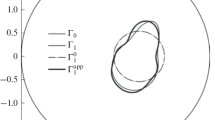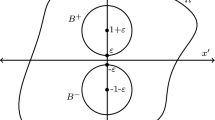Abstract
We deal with the problem of estimating the volume of inclusions using a small number of boundary measurements in electrical impedance tomography. We derive upper and lower bounds on the volume fractions of inclusions, or more generally two phase mixtures, using two boundary measurements in two dimensions. These bounds are optimal in the sense that they are attained by certain configurations with some boundary data. We derive the bounds using the translation method which uses classical variational principles with a null Lagrangian. We then obtain necessary conditions for the bounds to be attained and prove that these bounds are attained by inclusions inside which the field is uniform. When special boundary conditions are imposed the bounds reduce to those obtained by Milton and these in turn are shown here to reduce to those of Capdeboscq–Vogelius in the limit when the volume fraction tends to zero. The bounds of this article, and those of Milton, work for inclusions of arbitrary volume fractions. We then perform some numerical experiments to demonstrate how good these bounds are.
Similar content being viewed by others
References
Alessandrini G., Rosset E.: The inverse conductivity problem with one measurement: bounds on the size of the unknown object. SIAM J. Appl. Math. 58, 1060–1071 (1998)
Alessandrini G., Rosset E., Seo J.K.: Optimal size estimates for the inverse conductivity problem with one measurement. Proc. Am. Math. Soc. 128, 53–64 (2000)
Allaire G.: Shape Optimization by the Homogenization Method. Applied Mathematical Sciences, vol. 146. Springer-Verlag, New York (2002)
Ammari H., Kang H.: Reconstruction of Small Inhomogeneities from Boundary Measurements. Lecture Notes in Mathematics, vol. 1846. Springer-Verlag, Berlin (2004)
Ammari H., Kang H.: Polarization and Moment Tensors: with Applications to Inverse Problems and Effective Medium Theory, Applied Mathematical Sciences, Vol. 162. Springer-Verlag, New York (2007)
Berryman J.G., Kohn R.V.: Variational constraints for electrical-impedance tomography. Phys. Rev. Lett. 65, 325–328 (1990)
Capdeboscq Y., Vogelius M.S.: Optimal asymptotic estimates for the volume of internal inhomogeneities in terms of multiple boundary measurements. Math. Model. Numer. Anal. 37, 227–240 (2003)
Capdeboscq, Y., Vogelius, M.S.: A review of some recent work on impedance imaging for inhomogeneities of low volume fraction. In: Proceedings of the Pan-American Advanced Studies Institute on PDEs, Inverse Problems and Nonlinear Analysis, January 2003, 69–87, Contemporary Mathematics, vol. 362. American Mathematical Society, Providence (2005)
Cherepanov G.P.: Inverse problems of the plane theory of elasticity. PMM 38, 963–979 (1974)
Cherkaev A.V.: Variational Methods for Structural Optimization. Applied Mathematical Sciences, vol. 140. Springer-Verlag, New York (2000)
Eshelby J.D.: Elastic inclusions and inhomogeneities. In: Sneddon, I.N., Hill, R. (eds) Progress in Solid Mechanics, vol. II, pp. 87–140. North-Holland, Amsterdam (1961)
Grabovsky Y.: Bounds and extremal microstructures for two-component composites: A unified treatment based on the translation method. Proc. Roy. Soc. Lond. A 452, 919–944 (1996)
Hashin Z., Shtrikman S.: A variational approach to the theory of the effective magnetic permeability of multiphase materials. J. Appl. Phys. 33, 3125–3131 (1962)
Hashin Z., Shtrikman S.: A variational approach to the theory of the elastic behavior of multiphase materials. J. Mech. Phys. Solids 11, 127–140 (1963)
Hori M., Nemat-Nasser S.: Universal bounds for overall properties of linear and nonlinear heterogeneous solids. J. Eng. Mater. T. ASME 117, 412–432 (1995)
Hori M., Nemat-Nasser S.: Universal bounds for effective piezoelectric moduli. Mech. Mater. 30, 1–19 (1998)
Kang H.: Conjectures of Polya-Szego and Eshelby, and the Newtonian potential problem; a review. Mech. Mater. 41, 405–410 (2009)
Kang, H., Milton, G.W.: On conjectures of Polya-Szego and Eshelby. In: Kang, H., Ammari, H. (eds.) lnverse Problems, Multi-scale Analysis and Effective Medium Theory. Contemporary Mathematics, vol. 408, pp. 75–80. American Mathematical Society, Providence (2006)
Kang H., Milton G.W.: Solutions to the Pólya-Szegö conjecture and the weak Eshelby conjecture. Arch. Ration. Mech. Anal. 188, 93–116 (2008)
Kang H., Seo J.K., Sheen D.: The inverse conductivity problem with one measurement: stability and estimation of size. SIAM J. Math. Anal. 28, 1389–1405 (1997)
Kang H., Kim E., Milton G.W.: Inclusion pairs satisfying Eshelby’s uniformity property. SIAM J. Appl. Math. 69, 577–595 (2008)
Lipton R.: Inequalities for electric and elastic polarization tensors with applications to random composites. J. Mech. Phys. Solids 41, 809–833 (1993)
Liu L.P.: Solutions to the Eshelby conjectures. Proc. R. Soc. A 464, 573–594 (2008)
Liu, L.P., James, R., Leo, P.: New extremal inclusions and their applications to two-phase composites, preprint
Lurie, K.A., Cherkaev, A.V.: Accurate estimates of the conductivity of mixtures formed of two materials in a given proportion (two-dimensional problem). Doklady Akademii Nauk SSSR 264, 1128–1130 (1982). English translation in Soviet Phys. Dokl. 27, 461–462 (1982)
Lurie K.A., Cherkaev A.V.: Exact estimates of conductivity of composites formed by two isotropically conducting media taken in prescribed proportion. Proc. R. Soc. Edinb. A 99, 71–87 (1984)
Milton G.W.: Transport properties of arrays of intersecting cylinders. Appl. Phys. 25, 23–30 (1981)
Milton G.W.: The Theory of Composites. Cambridge Monographs on Applied and Computational Mathematics. Cambridge University Press, Cambridge (2002)
Milton, G.W.: Universal bounds on the electrical and elastic response of two-phase bodies and their application in bounding the volume fraction from boundary measurements. J. Mech. Phys. Solids (2011). doi:10.1016/j.jmps.2011.09.007
Murat, F., Tartar, L.: Calcul des variations et homogénísation. In: Les méthodes de l’homogénéisation: théorie et applications en physique, pp. 319–369. Eyrolles, Paris (1985). English translation in A. Cherkaev, A., Kohn, R. (eds.) Topics in the Mathematical Modelling of Composite Materials. Progress in Nonlinear Differential Equations and Their Applications, vol. 31, pp. 139–173. Birkhäuser, Boston (1997)
Nemat-Nasser S., Hori M.: Micromechanics: Overall Properties of Heterogeneous Materials, First edn. North Holland, Amsterdam (1993)
Sendeckyj G.P.: Elastic inclusion problems in plane elastostatics. Int. J. Solids Struct. 6, 1535–1543 (1970)
Tartar, L.: Estimation de coefficients homogénéisés. In: Glowinski, R., Lions, J.-L. (eds.) Computing Methods in Applied Sciences and Engineering: Third International Symposium, Versailles, France, December 5–9, 1977. Lecture Notes in Mathematics, vol. 704, pp. 364–373. Springer-Verlag, New York (1979). English translation in Cherkaev, A., Kohn, R. (eds.) Topics in the Mathematical Modelling of Composite Materials. Progress in Nonlinear Differential Equations and Their Applications, vol. 31, pp. 9–20. Birkhäuser, Boston (1997)
Tartar, L.: Estimations fines des coefficients homogénéisés. In: Krée, P. (ed.) Ennio de Giorgi Colloquium: Papers Presented at a Colloquium Held at the H. Poincaré Institute in November 1983. Pitman Research Notes in Mathematics, vol. 125, pp. 168–187. Pitman, London (1985)
Tartar L.: The General Theory of Homogenization: A Personalized Introduction, Lecture Notes of the Unione Matematica Italiana. Springer-Verlag, Berlin (2009)
Author information
Authors and Affiliations
Corresponding author
Additional information
Communicated by J. Ball.
Rights and permissions
About this article
Cite this article
Kang, H., Kim, E. & Milton, G.W. Sharp bounds on the volume fractions of two materials in a two-dimensional body from electrical boundary measurements: the translation method. Calc. Var. 45, 367–401 (2012). https://doi.org/10.1007/s00526-011-0462-3
Received:
Accepted:
Published:
Issue Date:
DOI: https://doi.org/10.1007/s00526-011-0462-3




